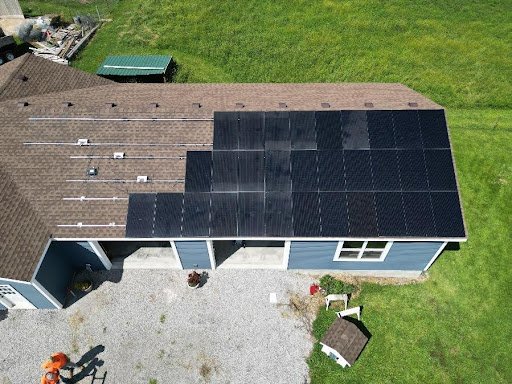Once the solar panel design process is complete, the work of installing solar panels can begin.
Solar panel installation firms in Kansas and Missouri, like solar firms nationwide, often aren’t the same companies that sold you your solar panels in the first place. Large nationwide solar firms operate armies of solar salespeople and have amazing marketing to get people to buy solar panels. But once you sign up they subcontract the actual work of installing solar panels to the lowest bidder.
Homeowner's Guide to Going Solar
We’ve put together this FREE comprehensive guide to going solar to help homeowners like you think about the pros and cons of going solar, and learn more about the installation process. →
Having your solar panels installed by some “Chuck-in-a-truck” outfit is not a good idea. Properly installed solar projects will last many decades, even in our extreme weather conditions, meaning you can be stuck with shoddy work for years. Cromwell Solar is often called to repair cheaply done solar installations that were botched by cut-rate firms, and we’re often amazed at the corners they are cutting to be able to install solar panels on a house in a single day. Make sure any solar company you talk to installs and maintains their own solar panels like we do at Cromwell Solar.
Solar panel installation safety
Cromwell Solar workers safely installing solar panels on a house.
The first objective of any quality solar panel installation is worker safety —a safe worksite is a sign of care. It is faster to install a rooftop solar project without safety gear like ropes and harnesses, and some solar installation companies forgo that equipment either because they are unaware of safety best practices, or because they are cutting corners to move quickly to the next project. Neither bode well for the quality of the solar installation.
A good solar firm will have a designated safety officer and each solar installation project should be scrutinized for its own unique hazards before a project starts. All solar installers should be certified through an OSHA safety training program.
Solar installation project layout
To transfer the solar design off the paper and into reality, we first carefully lay out the system on the roof. We take careful measurements to ensure the blueprints for the solar project match the reality of the solar installation, and use chalk lines to ensure perfectly straight rows of solar panels. Taking the time to lay out a solar project before installation begins ensures the best quality end product.
Solar rail system
While from a distance it often looks like solar panels are sitting directly on a sloped roof, they are actually mounted on aluminum rails just a few inches above the roof. The air space between the panels and the roof helps keep the panels cooler, which ensures better solar panel performance. An additional benefit in a solar installation is that a roof gets shaded by the solar panels mounted above it, protecting the shingles from weathering, and keeping the attic cooler.
A solar racking system with micro-inverters installed on a house roof in Missouri.
The solar rails are attached to the roof using “feet” that are secured to your roof. When installed properly the modern foot system is completely water-tight. On normal composition shingle roofs the foot is installed through the shingles, attaching to the roof rafters. For a good solar installation in windy Kansas or Missouri, we take care to ensure that the feet are in fact attached to the roof rafters and not just through the roof sheathing.
On metal standing-seam roofs, the solar feet are attached to the roof by a clamp that essentially squeezes the upright seam without penetrating the roof at all. For solar installations on flat roofs we use a ballast-mount system that sits on top of the roof and is secured by the weight of concrete blocks holding the system down.
With the solar rails now attached to the roof it is time for the most exciting step of the process — installing the solar panels themselves.
Mounting solar panels on a roof
While most exciting to watch (and perform), putting solar panels on the roof is actually one of the simplest parts of a solar installation. Solar panels are attached to the rails on your roof using aluminum clips that essentially clamp down or squeeze the aluminum frame of the solar panel to the aluminum rails on the roof. Cromwell Solar has installed thousands of solar panels on roofs, and we know exactly how to ensure your panels are mounted with care.
One additional installation necessity comes from wildlife. We have a lot of squirrels in Kansas and Missouri. For residential solar projects in areas with trees it is necessary to install squirrel guards to keep the wire-eating rodents from nesting under the panels. Most installers don’t want to take the time to install this essential protection for your system, so make sure your solar installer is including squirrel guards on your project.
Solar panels with squirrel guards installed on a roof in Topeka, Kansas.
As the panels are installed we begin to wire them together, taking care to maintain safety. Some solar panel components are electrified the moment the sun hits them, meaning they can deliver a shock if not treated properly.
Electrical interconnection and solar inverters
Whenever light hits the solar panels they produce direct or “DC” current. More intense sun yields more power up to the maximum of the panel being installed. This DC power needs to be converted into the AC power we use in our buildings, which is accomplished with a solar inverter. The inverter is the brains of a solar installation. If the solar project is connected to the grid, an inverter not only makes AC out of DC current, it synchronizes that AC power to match that of the utility grid, an essential step for grid interconnection. Installing a solar inverter is the work of skilled solar electricians.
Solar inverters can be either small “micro-inverters” that are needed for every panel or two or larger “string-inverters” that handle many panels. Micro-inverters can maximize the amount of power coming off of each separate solar panel, so they are less affected by partial shading. Today’s modern solar string inverters have made great progress in handling the differences in individual panel output, and are almost as effective as micro-inverters, but for solar installations with partial shade issues a micro-inverter is probably the best choice.
A home solar panel installation showing installed panels and solar rails in rural Kansas.
The solar panels are connected to the solar inverters, which are then connected to the building’s AC electrical system. For small solar panel installations, it is possible that the system is connected right to your electrical panel, much like wiring in any large appliance. For larger solar projects the connection is made through a line-side tap or directly into a transformer (often for very large industrial solar installations). Importantly, any electrical work on your home or building needs to be done by qualified electricians.
Monitoring a solar installation
Many solar inverters have built-in monitoring systems which allow you to see the historical and real-time output of your solar panels. A good solar monitoring system is not just for the satisfaction of watching how much energy you are making, however. Solar monitoring is really important for identifying problems like inverters that are not working and systems that are not generating the power they should. Early detection of issues means less solar panel downtime. In order to have online solar monitoring of your solar panels you will need to have internet access where your inverters are located.
The Enphase Solar Monitoring App
Cromwell Solar performs a lot of solar panel installations in rural areas of Kansas or Missouri where we may install solar panels on barns, detached garages, and in fields/yards on solar ground-mounts. These types of solar installations often do not have wireless internet access where we are installing the solar panels, but we often can still provide these solar projects with online solar monitoring. If wireless internet isn’t available at the solar panels or solar inverters, Cromwell can offer networking solutions such as cellular internet or Wi-Fi bridges for exterior or long-distance connections to allow access.
When the solar monitoring is set up and the system is functioning, the owner of a solar project will get access to the solar monitoring. Access can be from an app on your phone or through a website. Having online access to your solar panel production allows you to see how much energy your solar panels are making but can also allow you the benefit of seeing how much energy you are consuming in your building at any time, which is an important piece of information as you seek to further save energy.
The installation of solar monitoring systems is very important to the overall function and efficiency of a solar panel system, but that installation is complicated. It is important that your solar technicians are certified in the products they are installing.
Final solar panel commissioning
The last step of a solar panel installation is the final commissioning. During this part of the solar panel installation process the system is tested and final inspections occur with the local building department and the utility company. If the project is sound a “permission to operate” or PTO is given and the system can be officially turned on. We provide the solar project owners with system documentation and educate you about the system so you know how to use and maintain it. At this point you are generating your own clean energy, saving money while providing a cleaner environment for your community.







